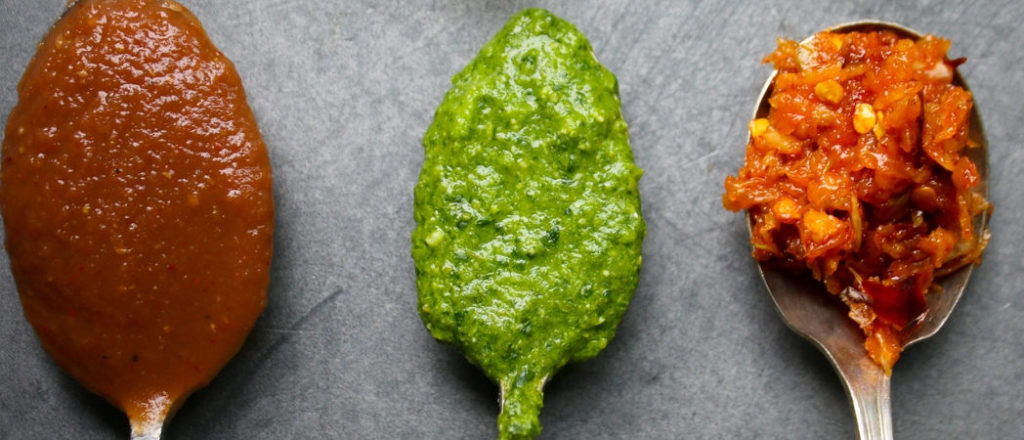
Indian cuisine is celebrated for its rich tapestry of flavors, and chutneys play a pivotal role in this culinary landscape. These versatile condiments, varying in taste, texture, and ingredients, are integral to Indian meals, offering a burst of vibrant and complementary flavors. The tradition of incorporating chutneys into Indian foods is deeply rooted in history, cultural diversity, and a holistic approach to gastronomy. Let’s explore the multifaceted reasons why chutneys are an inseparable part of Indian culinary traditions.
1. Diverse Regional Cuisines:
India is a diverse country with a myriad of regional cuisines, each boasting its unique flavors and culinary techniques. Chutneys, often influenced by local ingredients and tastes, add a distinct regional flair to dishes. From the fiery and tangy green chutneys of North India to the sweet and tangy tamarind-based chutneys of the South, these variations showcase the diversity and richness of Indian gastronomy.
2. Balancing Flavors:
Indian cuisine is known for its harmonious blending of sweet, salty, sour, bitter, and umami flavors. Chutneys serve as flavor enhancers, contributing the missing notes to achieve a well-balanced and satisfying taste profile in a meal. A dollop of chutney can transform a dish by providing the necessary contrast or accentuating existing flavors.
3. Enhancing Textures:
Beyond flavor, chutneys contribute to the sensory experience of a meal by introducing diverse textures. Whether it’s the crunch of peanuts in a chutney from Maharashtra or the smooth consistency of coconut chutney in South India, these textural contrasts add depth and interest to the overall dining experience.
4. Preservation of Seasonal Ingredients:
Chutneys have historically played a crucial role in preserving seasonal fruits, vegetables, and herbs. By transforming perishable ingredients into chutneys, communities could enjoy their flavors year-round. This practice aligns with the sustainable use of local produce and ensures a continuous supply of essential nutrients even during off-seasons.
5. Ayurvedic Principles:
Indian cuisine is deeply influenced by Ayurveda, the ancient system of holistic health and well-being. Ayurvedic principles emphasize the importance of balancing the six tastes (sweet, sour, salty, pungent, bitter, and astringent) in every meal to promote overall health. Chutneys, with their diverse flavor profiles, contribute to achieving this balance, making them an integral part of Ayurvedic-inspired cooking.
6. Aid to Digestion:
Many traditional chutney ingredients, such as ginger, garlic, and mint, are known for their digestive properties. Incorporating these elements into chutneys aligns with the belief that a well-spiced and flavorful diet supports optimal digestion. Chutneys are often served alongside heavier dishes to enhance the overall digestibility of a meal.
7. Complement to Spice-rich Dishes:
Indian cuisine is renowned for its use of spices, creating complex and aromatic flavors. Chutneys act as a delightful counterbalance to spice-rich dishes by offering a refreshing and cooling element. Yogurt-based chutneys, like raita, are particularly popular for their soothing effect when paired with fiery curries or kebabs.
8. Versatility in Usage:
Chutneys showcase incredible versatility in their applications. They can serve as dips, spreads, marinades, or accompaniments to main courses. Whether paired with bread, rice, dosas, or grilled meats, chutneys effortlessly adapt to a wide array of dishes, adding an extra layer of excitement to each culinary creation.
9. Cultural Significance:
Chutneys are deeply ingrained in the cultural fabric of Indian communities. They are often passed down through generations, with each family having its cherished recipes. The act of preparing and sharing chutneys is a cultural tradition that fosters connection and a sense of belonging within families and communities.
10. Celebration of Festivals and Special Occasions:
Indian festivals and special occasions are marked by a profusion of flavors and culinary delights. Chutneys, prepared with festive ingredients and aromatic spices, are an integral part of these celebratory feasts. They add a touch of indulgence to the festivities, making meals during special occasions memorable and distinctive.
11. Culinary Creativity:
Chutneys provide a canvas for culinary creativity. Chefs and home cooks alike experiment with different combinations of herbs, spices, fruits, and vegetables to create unique chutneys. This creativity adds a dynamic and evolving aspect to Indian cuisine, ensuring that it remains vibrant and adaptable to changing tastes.
12. Adaptation to Vegetarian Diets:
Given the prevalence of vegetarianism in many parts of India, chutneys contribute significantly to the flavor and nutritional content of vegetarian meals. They serve as an essential component that elevates the taste and appeal of vegetarian dishes, making them satisfying and enjoyable.
13. Connection to Street Food Culture:
Indian street food, a vibrant and integral part of the culinary scene, often features chutneys as essential components. Whether it’s the tangy tamarind chutney in chaat or the mint chutney in kebabs, these condiments are central to the street food experience, offering bursts of flavor that define these popular dishes.
14. Influence on Global Cuisine:
As Indian cuisine gains popularity worldwide, chutneys have become global culinary ambassadors. They are embraced in fusion dishes, incorporated into international recipes, and celebrated for their ability to elevate the taste profile of a wide range of global cuisines.
15. Adaptation to Modern Lifestyles:
In the fast-paced modern lifestyle, where convenience often takes precedence, chutneys offer a quick and easy way to enhance the flavor of meals. Ready-made chutneys are readily available in markets, catering to the needs of individuals seeking delicious and time-efficient meal solutions.

In conclusion, chutneys are an indispensable aspect of Indian cuisine, contributing to its richness, diversity, and holistic approach to food. Beyond being flavorful condiments, they embody cultural traditions, adapt to regional variations, and showcase the creativity and adaptability of Indian culinary practices. As a culinary art form, chutneys continue to evolve, providing a dynamic and exciting dimension to the ever-evolving world of Indian gastronomy.







